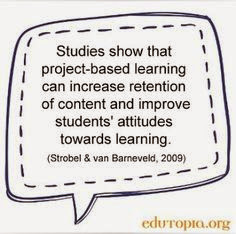Dr. Strange assigned six different videos for us to watch, and then asked a very good question. He asked us, "What can we learn about teaching from these teachers?" All these teachers had great advice and great things to say, but all of them had one thing in common, Project Based Learning.
The first video was Back To The Future, done by Brian Crosby at Agnes Risley Elementary school in Sparks, Nevada. In his class, every student in his class had a laptop. Mr. Crosby really took advantage of this tool in his classroom. One thing that I learned from him is that you really need to engage the students in their learning. He did an awesome project where students had a huge balloon. They attached a video camera to it and sent it up into the air. They watched this balloon float up on a computer. After watching what happened to this balloon as it got higher and higher, they wrote a narrative in their blogs. They wrote as if they were the balloon. Mr. Crosby combined a Science lesson with an English lesson.
This project brought something very cool to this classroom. It started a learning network for this class. Other students from around the world saw these students blog and wanted to know about their project, and how it was done. I learned that by getting students to blog about their experiences in the classroom, they are forming a learning network, and getting to connect with other students. I thought this was very neat. His students were so excited to know that other people were seeing their hard work.
The second video was Blended Learning Cycle by Paul Anderson. I learned two very important things from Mr. Anderson. The first thing was the five E's. They are engage, explore, expand, explain, and evaluate. He uses these five E's to get his class excited about what they are learning. The next thing I learned from him is the acronym QUIVERS.
"QU" stands for question, "I" stands for investigate/inquiry, "V" stands for video, "E" stands for elaboration, "R" stands for review, and "S" stands for summary quiz. He uses this acronym in his class on a daily bases. He always starts a lesson out by asking a question. This really gets his class thinking about what his is going to teach about. Then they investigate the subject. He always has a video of himself talking about the subject. This gives him time to get some one on one time with his students. He then elaborates on the subject, reviews with his students to make sure they are really understanding what they were taught. At they end, he gives his students a summary quiz on the subject.
The third video was Making Thinking Visible by Mark Church. In this video the teacher was getting his students to work in small group. They were asked as a group to come up with a headline about they puzzle they were working on. I learned that students need to interpret and connect what they know. At the end of the year they were going to look back on this project and see how their headline has changed and their learning has progressed.
The fourth video was Building Comics by Same Pane. Mr. Pane teaches fourth grade. Mr. Pane was teaching his students about being safe, responsible, and respectful online. He did this by letting they students build a comic using a special program on their laptops. They had to create a narrative and make it about themselves. I learned that by letting the students make their narrative about them, it makes it more meaningful to them. After finishing their comic, the students got to walk around and look at the "gallery", which was all they students different comics.
The fifth video was Project Based Learning by Dean Shareski. I learned a lot from him! He taught me that PBL increases students understanding about the subject being taught. I also learned that when students use technology, they bring to life what they are learning. The last thing I learned was to always ask your students what they can do to make whatever they are working on better?
The sixth video was Roosevelt Elementary's PBL Program. This video taught me that PBL teaches students to think for themselves. It also starts students in public speaking early. This is good because it helps them to not be as nervous as the years progress. PBL also gives students that chance to make their own choices and use real world skills. PBL teaches students how to work together and communicate. I also learned that PBL helps to differentiate learning styles and curriculum integration.
photo source: www.edutopia.org

Your post was very thorough. You had one grammar mistake in the fifth paragraph!
ReplyDeleteVery good post this week :)
ReplyDelete